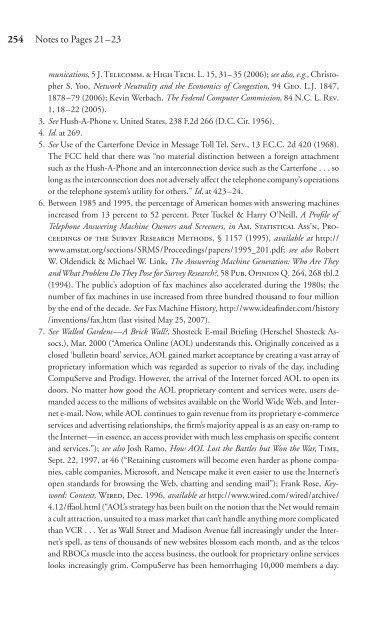Download - Future of the Internet â And how to stop it.
Download - Future of the Internet â And how to stop it.
Download - Future of the Internet â And how to stop it.
You also want an ePaper? Increase the reach of your titles
YUMPU automatically turns print PDFs into web optimized ePapers that Google loves.
254<br />
Notes <strong>to</strong> Pages 21–23<br />
munications, 5 J. TELECOMM. & HIGH TECH. L. 15, 31–35 (2006); see also, e.g., Chris<strong>to</strong>pher<br />
S. Yoo, Network Neutral<strong>it</strong>y and <strong>the</strong> Economics <strong>of</strong> Congestion, 94 GEO. L.J. 1847,<br />
1878–79 (2006); Kevin Werbach, The Federal Computer Commission, 84 N.C. L. REV.<br />
1, 18–22 (2005).<br />
3. See Hush-A-Phone v. Un<strong>it</strong>ed States, 238 F.2d 266 (D.C. Cir. 1956).<br />
4. Id. at 269.<br />
5. See Use <strong>of</strong> <strong>the</strong> Carterfone Device in Message Toll Tel. Serv., 13 F.C.C. 2d 420 (1968).<br />
The FCC held that <strong>the</strong>re was “no material distinction between a foreign attachment<br />
such as <strong>the</strong> Hush-A-Phone and an interconnection device such as <strong>the</strong> Carterfone ... so<br />
long as <strong>the</strong> interconnection does not adversely affect <strong>the</strong> telephone company’s operations<br />
or <strong>the</strong> telephone system’s util<strong>it</strong>y for o<strong>the</strong>rs.” Id. at 423–24.<br />
6. Between 1985 and 1995, <strong>the</strong> percentage <strong>of</strong> American homes w<strong>it</strong>h answering machines<br />
increased from 13 percent <strong>to</strong> 52 percent. Peter Tuckel & Harry O’Neill, A Pr<strong>of</strong>ile <strong>of</strong><br />
Telephone Answering Machine Owners and Screeners, in AM. STATISTICAL ASS’N, PRO-<br />
CEEDINGS OF THE SURVEY RESEARCH METHODS, § 1157 (1995), available at http://<br />
www.amstat.org/sections/SRMS/Proceedings/papers/1995_201.pdf; see also Robert<br />
W. Oldendick & Michael W. Link, The Answering Machine Generation: Who Are They<br />
and What Problem Do They Pose for Survey Research, 58 PUB. OPINION Q. 264, 268 tbl.2<br />
(1994). The public’s adoption <strong>of</strong> fax machines also accelerated during <strong>the</strong> 1980s; <strong>the</strong><br />
number <strong>of</strong> fax machines in use increased from three hundred thousand <strong>to</strong> four million<br />
by <strong>the</strong> end <strong>of</strong> <strong>the</strong> decade. See Fax Machine His<strong>to</strong>ry, http://www.ideafinder.com/his<strong>to</strong>ry<br />
/inventions/fax.htm (last vis<strong>it</strong>ed May 25, 2007).<br />
7. See Walled Gardens—A Brick Wall, Shosteck E-mail Briefing (Herschel Shosteck Assocs.),<br />
Mar. 2000 (“America Online (AOL) understands this. Originally conceived as a<br />
closed ‘bulletin board’ service, AOL gained market acceptance by creating a vast array <strong>of</strong><br />
proprietary information which was regarded as superior <strong>to</strong> rivals <strong>of</strong> <strong>the</strong> day, including<br />
CompuServe and Prodigy. However, <strong>the</strong> arrival <strong>of</strong> <strong>the</strong> <strong>Internet</strong> forced AOL <strong>to</strong> open <strong>it</strong>s<br />
doors. No matter <strong>how</strong> good <strong>the</strong> AOL proprietary content and services were, users demanded<br />
access <strong>to</strong> <strong>the</strong> millions <strong>of</strong> webs<strong>it</strong>es available on <strong>the</strong> World Wide Web, and <strong>Internet</strong><br />
e-mail. Now, while AOL continues <strong>to</strong> gain revenue from <strong>it</strong>s proprietary e-commerce<br />
services and advertising relationships, <strong>the</strong> firm’s major<strong>it</strong>y appeal is as an easy on-ramp <strong>to</strong><br />
<strong>the</strong> <strong>Internet</strong>—in essence, an access provider w<strong>it</strong>h much less emphasis on specific content<br />
and services.”); see also Josh Ramo, How AOL Lost <strong>the</strong> Battles but Won <strong>the</strong> War, TIME,<br />
Sept. 22, 1997, at 46 (“Retaining cus<strong>to</strong>mers will become even harder as phone companies,<br />
cable companies, Micros<strong>of</strong>t, and Netscape make <strong>it</strong> even easier <strong>to</strong> use <strong>the</strong> <strong>Internet</strong>’s<br />
open standards for browsing <strong>the</strong> Web, chatting and sending mail”); Frank Rose, Keyword:<br />
Context, WIRED, Dec. 1996, available at http://www.wired.com/wired/archive/<br />
4.12/ffaol.html (“AOL’s strategy has been built on <strong>the</strong> notion that <strong>the</strong> Net would remain<br />
a cult attraction, unsu<strong>it</strong>ed <strong>to</strong> a mass market that can’t handle anything more complicated<br />
than VCR ... Yet as Wall Street and Madison Avenue fall increasingly under <strong>the</strong> <strong>Internet</strong>’s<br />
spell, as tens <strong>of</strong> thousands <strong>of</strong> new webs<strong>it</strong>es blossom each month, and as <strong>the</strong> telcos<br />
and RBOCs muscle in<strong>to</strong> <strong>the</strong> access business, <strong>the</strong> outlook for proprietary online services<br />
looks increasingly grim. CompuServe has been hemorrhaging 10,000 members a day.


